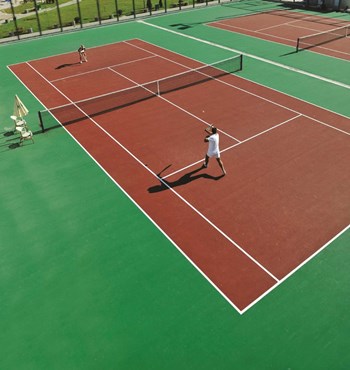
Gone are the days when a treadmill and a set of dumbbells in a fluorescent-lit basement room passed for athletic amenities in condo buildings and HOAs. Today, the size and scope of sporty offerings—be it basketball courts, pools or saunas—varies from association to association, but regardless of the specific facility, providing a safe, insured environment compliant with both governing documents and applicable laws is critical, and the responsibility falls to board members and community administrators.
Key Concerns
For many Florida-based home owner associations and condominiums, residents are afforded the use of pools and tennis courts, among other amenities such as golf putting greens, fully equipped exercise rooms and shuffle board courts. Aside from the physical upkeep of equipment and facilities, drafting and enforcing rules and regulations for the safe enjoyment of these services is essential. Equally important is hiring qualified, competent supervisory staff.
“The [board's] primary concerns are caring for the safety and enjoyment of the residents, limiting the board’s exposure to liability and minimizing the costs for the condominium unit owners,” says Associate Attorney Paula S. Buzzi, Esq., from law firm Saavedra & Goodwin, based in Fort Lauderdale.
Since many boards change seats annually, the preparation of sound governing documents pertaining to athletic amenities is vital. To this end, boards should have a check list of “concerns” when drafting or revisiting rules and regulations. “Fairness, reasonableness, insurance concerns, safety, uniformity of rules and enforcement thereof, dealing with kids versus adults, liability, accessibility and disability access should all be considered,” says Associate Attorney Alessandra Stivelman with the Hollywood-based law firm Eisinger, Brown, Lewis, Frankel & Chaiet, P.A.
A Universal Approach
When considering what rules and restrictions will be placed on the amenity in question, industry experts strongly encourage boards to take a fair, unified approach. While liability is always a concern, an incautious or unthinking board can also subject itself to a discrimination case. “Uniform enforcement of rules and regulations is a big deal,” says Telese McKay, founder and shareholder of McKay Law, based in Bradenton. “There are cases where rules can be too restrictive, such as hours of operation. Boards have to consider user rights.”
While hours of operation and access to certain buildings can be controlled by key cards and the like, for associations with pools, tennis courts and showering facilities that are adjacent to public beaches or parks, it becomes a challenge to keep trespassers off the premises. “This is often a constant struggle for boards,” says McKay. Some boards will opt for security guards, or install monitoring cameras, but she adds this comes at a cost, which can sometimes be prohibitive for smaller or more modestly-funded communities.
Regardless of budgetary capabilities, boards are charged with determining fair use of all amenities among all residents. When it comes to access control, boards have to ensure that they are operating within the confines of the law when determining who gets to use facilities and when, how access is granted or rescinded, the policy on guest users, just to name a few related security concerns.
“How access is granted depends on the specific facility. Security is always a concern and precautions depend on the actual facility and type of facility,” says Stivelman. “Access rights may be suspended (pursuant to statute) and sometimes it is difficult to enforce. Some associations have rules and regulations that limit the number of guests, or require that guests must be accompanied by owners. Parking considerations and requests for private use can also become issues that should be discussed, and regulations uniformly enforced.”
Aside from access and oversight, another leading concern involving athletic amenities is the issue of noise, explains Buzzi. “One of the most critical considerations in determining the hours of operation is the proximity of the athletic amenities to the actual condominium units,” he says. “For example, longer and/or later hours of operation would be more tolerable if the athletic amenities are located in a separate wing or building apart and far from the condominium units.”
If the athletic amenities are located close to individual units (sharing walls, or on the same floor, for example) Buzzi says it would be inconsiderate and inappropriate to have extended hours of operation. “An additional consideration in conjunction with that is the general environment and age of the residents,” he continues. “A condominium with younger residents would more likely value longer and later hours of operation for the athletic amenities than a condominium environment with a more elderly population.”
In the event an association suspends an owner's usage privileges, the board and managing agent may have a difficult time with enforcement,” says Stivelman. To ensure compliance, she says boards should take the necessary steps to inform all residents. “Enforcement will depend on the type of access and security provided at the facilities. Rules and regulations should be clear and when possible, posted on the property.”
Staffing & Insurance Concerns
For many boards and management companies, deciding on best practices when it comes to amenity access and staffing can become cause for debate. In some cases, staffing can be outsourced, while in other scenarios the position can be filled in-house - or not at all.
“This decision should be based on custom and availability of personnel, and it depends on specific facility, its needs and the association’s budget,” says Stivelman. “There may be insurance implications and less board control when staffing is outsourced; however, it may be easier or more manageable to outsource. Details can always be figured out in contract with outsourcing company.”
When approaching the issue of staffing, Buzzi agrees with Stivelman in that a cost-benefit analysis should be conducted on whether to outsource staffing or have in-house employees monitor the facilities. “There are many factors to consider, based on the amenities offered, the costs and liabilities involved,” he says. “The board has to consider the additional expense of staffing the amenities with trained personnel, such as lifeguards and trained fitness staff, as well as what the risks might be of not doing so.”
With staffing comes liability, which is above and beyond the liability for the amenity itself, explains McKay. “Many associations have general liability policies, but they need to discuss the extent of the coverage with their insurance agent,” says McKay. “Just because you have general liability insurance doesn’t mean you won’t get sued.”
In some cases McKay said associations will require residents and/or guests to sign a waiver to use the amenity. “I see some benefit in using them, but they aren’t mandated.” Common liability issues usually center around children jumping or diving in the pool, and broken glass around the pool; however McKay says reasonable steps can be taken to minimize exposure to a lawsuit.
Staying Competitive
“Whether the amenities are worth the increased insurance burden depends on the unit owners and what they value and can afford as a whole,” says Buzzi. “Just take a look at the tri-county area. There is a condominium boom going on right now. You need your building to stay competitive in this real estate market against the newer buildings erected with the latest amenities. You don’t want your building to become a dinosaur.”
In some cases, having state-of-the-art amenities is the cost of doing business. Like Buzzi notes, it is how properties can remain competitive and vital. For many boards still struggling with post Great Recession budget woes—it’s hard to strike a balance.
“Having the amenities will certainly increase the value of the property and be a benefit to the owners; however, it could be a financial burden. Obviously, the more claims filed the higher the insurance premium,” says Stivelman. “Insurance will generally defend the association from lawsuits and claims. Notwithstanding, there would always be appropriate security and lifeguards in place and a procedure for reporting injuries.”
As McKay notes, in the event of a serious accident—even one that results in a death on the association’s property—a waiver can help protect the board from being liable. However, this is not the only course of action—nor is it a fail-safe.
“HOAs and condominiums typically have a legal obligation to attend to any dangerous condition that arises in the athletic amenities,” says Buzzi. “Whether or not a condominium association is liable for injury or death related to an incident involving the athletic facility would depend on the specific circumstance. A waiver or consent form with strict waiver-of-liability language may help protect community associations in cases of injury or death, but employees should be vigilant about the conditions of equipment and amenities to avoid accidents.”
In Stivelman’s experience waivers should always be used by boards; however there is often a grey area when it comes to enforcement. “Waivers and consents are generally deemed unenforceable, since one cannot waive future claims, but they should always be used,” she says. “They should be comprehensive, and the facility should ensure that the user reads and understands the waiver so as to constitute informed consent.”
When it comes to all regulations related to amenities, boards should take a progressive, proactive stance, rather than reacting to a problem or incident after the fact. “I see a lot of boards with good intentions,” says McKay. “But they deal with an issue afterward, when it’s often too late. They should draft their rules and regulations when there is no issue. They should then have an attorney review it and make sure the rules are enforceable.”
Since board member change posts frequently, there are often some well-intended new members who are not up to speed on amenity related issues. This could potentially be a serious problem, says Buzzi.
“Some of the most common problems and issues that boards and property managers face stem from not understanding their obligations and risks,” he says. “I am often surprised at the demands made of lay boards by their unit and homeowners. We expect a lot of our boards. My advice would be to make sure property managers and HOA boards consult with attorneys who specialize in community associations in order to avoid problems and liabilities in the future.”
Brad King is a freelance writer and a frequent contributor to The South Florida Cooperator.






Leave a Comment